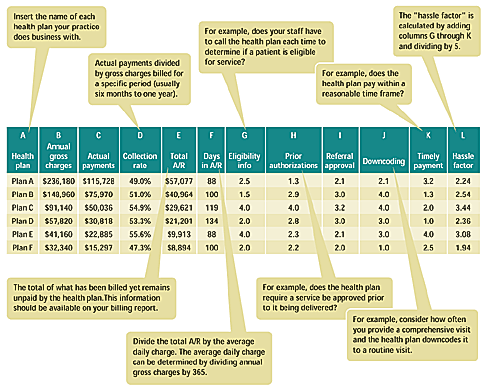
Dropping certain health plan contracts can boost your bottom line and reduce hassles. The author’s spreadsheet will enable you to choose carefully.
Fam Pract Manag. 2003;10(4):47-50

Most physicians have never terminated a health plan contract. Others have done so without adequate analysis or a full understanding of the effect it will have on their practices. In today’s climate of eroding payments and growing hassles, it makes good sense to look critically at every health plan you do business with to identify the keepers. Done properly, the process will net you improved payment for your services, fewer hassles and undiminished patient volume.
Begin by collecting data
The first step in determining which plans you want to continue to do business with requires allocating your costs by health plan. You’ll find most of the data you need (e.g., gross charges, payments, age of accounts receivable and number of patient encounters by health plan) in your receivables reports. If you don’t have an electronic billing system, you’ll need to manually review your explanations of benefits (EOBs). To make the process less laborious, review only a representative sample of the EOBs you’ve received from each of your major payers over the last year. With the data you gather, you’ll be able to calculate the collection rate, average charge and payment per encounter associated with each plan. Your ultimate goal should be to determine how much it costs you to deliver services under each plan so that you can calculate net income per plan. If this seems impractical, you can still conduct a valuable assessment by focusing on revenues.
You’ll need more than just financial criteria to reliably evaluate the health plans you contract with. When plans with low levels of service force your practice to consume inordinate resources, service issues can outweigh financial considerations. For example, plans that are chronically slow paying or that make it difficult for you to get authorizations or referrals may result in your staff spending excessive amounts of time on the phone with plan representatives. To determine a “hassle factor” for each plan, ask several key staff members to rate each plan on a scale of 1 to 5 (with 5 being the best) in several service-related performance areas and then determine the average.
The spreadsheet on page 49 permits you to directly compare plan performance across financial and service parameters. (See the box on page 49 to download a working copy of the spreadsheet.) When inputting financial data into the spreadsheet, be sure to use actual data, not a plan’s published fee schedule, and make certain that co-payments and deductibles are reflected. When projecting future payments, be certain to factor in withholds, pending reductions in physician payments and other things that might affect what you’re likely to receive from each plan.
KEY POINTS
Simply dropping poor-performing health plans may not be the best decision, especially if that plan represents a large part of your practice’s income.
Instead, evaluate each health plan in terms of what it pays you to deliver your services to its patients as well as the plan’s “hassle factor.”
Once you’ve determined how much each plan costs your practice, you can project how much you’ll save by terminating a plan.
Develop a strategy
As you compare health plans, it’s important to have a strategy. For example, your strategy may be to raise your overall collection rate by 10 percent. Use what you have found thus far in the process to project earnings and determine how each plan relates to your practice’s overall strategy. Be sure to evaluate the risks of terminating each contract, including any potential loss of income and any changes in working relationships with colleagues. Also, consider how well you’ll be able to tolerate the possible adverse effects associated with these risks before taking any action. In addition, don’t make a decision to terminate after reviewing just one or two plans. Take a look at all your plans to gauge their relative importance to your practice.
Tempting as it may be, simply dropping a low-paying health plan may not be in your best interest, especially if that plan represents a large portion of your income. The smarter decision may be to continue to tolerate that health plan while taking incremental steps toward your goal, as in the following example comparing health plans C, D and F on the spreadsheet. Although health plan F scores relatively well on the age of its receivables, it has a low collection rate and a high hassle factor, making it appear to be a good candidate for termination. Health plan D has an average collection rate, but is slow paying and scores below average on the hassle factor. Finally, health plan C enjoys a slightly better than average collection rate, performs well on the hassle factor, but is below average in paying claims. Since it also represents a fairly large portion of the practice’s volume, it is not the best candidate for termination, unless that lost volume can be replaced. The better strategy might be to eliminate health plan F and focus on trying to attract more fee-for-service patients to build volume in preparation for terminating your contract with plan C. You might also decide to close your practice to new patients from plan C.
10 TIPS FOR EVALUATING HEALTH PLAN PERFORMANCE
Don’t base your decision to terminate a health plan solely on financial considerations.
Consider the “hassle factor,” including how easy or difficult a plan is to work with, how promptly it pays and how often it downcodes your services.
Other factors influencing your decision should include the competitiveness of the local market and the unique characteristics of your practice; these will affect your ability to replace lost volume.
Review gross charges, age of accounts receivable and collection rate, among other benchmarks, for each plan you contract with.
Much of the data you’ll need to evaluate health plan performance is in your routine receivables reports.
Weigh all the factors and consider their relative importance before deciding which health plans to terminate.
Determine how much volume you can afford to give up.
If your schedule is full and patients are enduring lengthy waits for appointments, you should be more aggressive in terminating poorly performing plans.
Thoroughly review the contract before deciding to cut a health plan.
Speak to the administrators of health plans you are considering dropping. Some will negotiate.
Read the fine print
Before terminating a relationship with a health plan, be certain to read (or reread) your contract. Contract language is not always clear and there may be some surprises, such as future obligations and requirements for cancellation. Some health plans will require physicians to continue caring for their patient population until replacement physicians can be found. This obligation can extend well past the date the contract is terminated. I also know of practices that have terminated an HMO contract for good reasons, only to find that the plan offered PPO and POS options and that the agreement contained an “all products” provision.
COMPARING HEALTH PLANS
Below is a sample spreadsheet, constructed in Microsoft Excel, that shows how you can directly compare the value of the health plans you do business with. Columns B through F focus on hard financial data while Columns G through K take into account the level of service the plan provides.
If your practice uses a computerized billing system, most of the financial data will be readily available. If not, you’ll have to manually review a representative sample (generally six months to one year) of explanation of benefits statements (EOBs) for each plan. For columns G through K, simply ask a few key employees to rate each plan’s level of service on a scale of 1 to 5 (with 5 being the best) and enter the average of those ratings in the appropriate cells. Click below to download this spreadsheet and modify it for use in your own practice.

Before terminating a contract, you should also consider how events in your local medical community, such as the large-scale abandonment of HMO contracts or declining reimbursement for physicians, might affect your group’s ability to replace lost patient volume. Political issues must also be weighed. For example, perhaps you decide to eliminate a particular health plan that has resulted in a lot of referrals to a particular cardiology group. Your decision might adversely affect the cardiology group’s bottom line. In this case, I’d advise you to hold a caucus with the group to share your findings and inform them of your decision to drop the health plan. The information will be better received if you present them with a thorough and thoughtful analysis and if you show concern for the welfare of their practice as well as your own. The importance of anticipating the reactions of those who will be affected and understanding the terms of a health plan agreement before you act cannot be overemphasized.
A RAW DEAL?
Assessing a health plan you already know is performing poorly still has its benefits. For example, it isn’t uncommon for discussions between physicians and health plan administrators to be governed by emotion instead of by facts. If talk becomes heated, it may become difficult to see any ground for compromise with the health plan. I know of several physicians who terminated contracts based on nothing more than a knee-jerk response to their frustration.
By conducting a thorough assessment, you will have a far better idea of the problems in your contract as well as what you can afford or are willing to endure to make your situation better. This will make you much better prepared to sit down with a health plan administrator and have a fact-based discussion about the difficulties of working with the plan and the impact it has on your practice’s bottom line.
Prioritize
After crunching the numbers, you may find that you contract with more than one health plan that does not meet your expectations. In that case, you’ll need to prioritize by determining how much volume you can afford to give up. Much will depend on your local market. In competitive markets, it’s often difficult to acquire new, better-paying volume.
Once you identify the health plans you want to keep doing business with, talk to the administrators of the plans you are considering dropping. Some administrators are willing to negotiate. If you decide to negotiate, part of your preparation should include learning more about what’s going on inside the health plan. For example, if you learn that the health plan is short on primary care physicians and that the loss of your practice would make it difficult for the health plan to meet its obligations, you can approach the conversation more aggressively, perhaps by asking that reimbursement be raised to a specific percentage above the resource-based relative value scale (RBRVS). We’ve seen even small practices benefit from this strategy.
Successful negotiation often depends on how well prepared you are. If you have done your homework and assessed each plan in terms of its financial value and service levels, it will be evident. Finally, don’t attempt to negotiate unless you are prepared to take action. If they show some interest in solving the problems, identify a time frame to resolve matters. Otherwise, follow through and move on.
Be patient
It may take three or four years to realize your objectives, but the process will pay off. Implementing a well-thoughtout strategic plan will help you identify poor-performing health plans and determine which ones you can afford to terminate. Even if your final decision is not to drop a plan, a systematic evaluation such as the one presented here can be valuable when it comes to negotiating new terms.